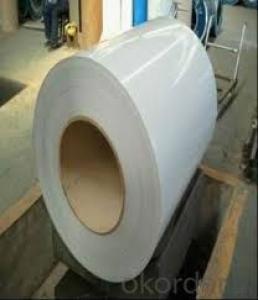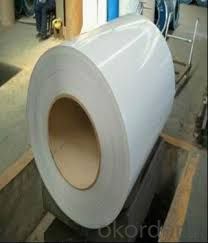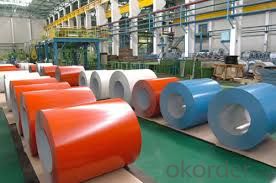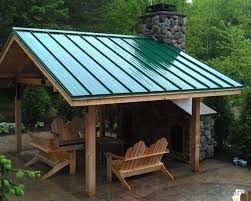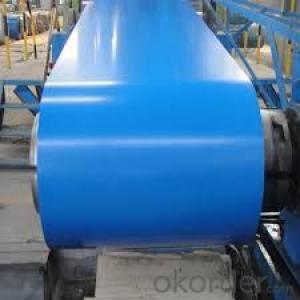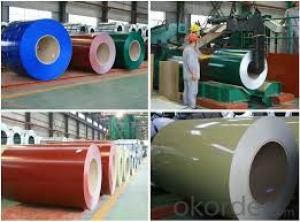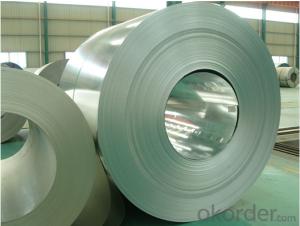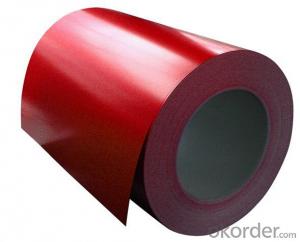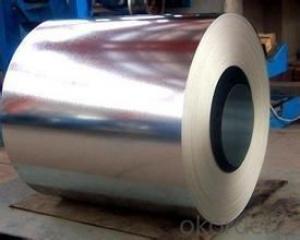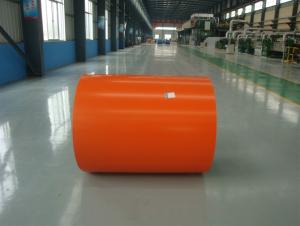Manufacturing Prepainted Galvanized Steel with Zinc Coated/Cold Steel Rolled
- Loading Port:
- Shanghai
- Payment Terms:
- TT OR LC
- Min Order Qty:
- 20 m.t.
- Supply Capability:
- 10000 m.t./month
OKorder Service Pledge
OKorder Financial Service
You Might Also Like
Product Description
Color Coated Galvanzied Steel
1, Grade: SGCC, PPGI CGCC, SGLCC
2, Width: 800-1250mm
3, Thickness: 0.3-1.0mm
4, Color: ALL RAL
* Base Material: Al-Zn Galvanized Steel Coil. SGLCC
* Top side: 15-25 microns primer microns polyester.
* Back side: 5-8 microns primer epoxy.
* Width: 800-1, 250mm
* Thickness: 0.3 -1.0mm Thickness tolerance: +/- 0.02mm
* Al-Zn coating: 30-150g /sq. M. Or can be provided as clients' requirements
* Color: All RAL colour is available or customer supplying the sample
* Inner diameter of coil: 508mm&610mm.
* Packing: Standard seaworthy packing or according to user's need.
* Weight of each coil: 9 tons max
* Guarantee/ warranty
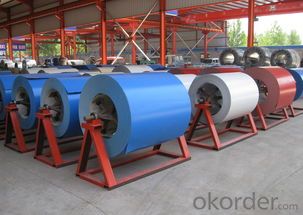
Usage
1. Used as roof panel, wall panel in steel structure in warehouse, factories, exibition hall container houses, cold storage,
2. It is also mainly used in light industry, automobile, construction, animal husbandry, fishery and commerce, etc.
Packing
1. Metal band strapping
2. Outside diameter ring
3. Label
4. Protective steel sheet
5. Water and rustproof paper
6. Steel sheet
Q&A Do you accept OA payment terms?
ANSWER: Yes, sure, but it normally depending on the order value
- Q: What are the different types of edge treatments for steel coils?
- Steel coils can undergo different edge treatments, each serving a specific purpose and offering unique benefits. 1. The most commonly used edge treatment is the slit edge. This involves cutting the coil along its width, resulting in two distinct edges. Slit edges are usually smooth and free from burrs, making them suitable for most applications. 2. The mill edge is the untreated edge of a steel coil straight from the rolling mill. It has a rough and uneven surface with visible imperfections like burrs and irregularities. Mill edges are generally not suitable for direct use and require further processing or trimming to achieve the desired edge quality. 3. The trimmed edge is a treatment that involves removing the rough and irregular portions of the mill edge. This is done through shearing or cutting, resulting in a smoother and more consistent edge. Trimmed edges are commonly used when a clean and uniform appearance is required. 4. Deburred edge refers to the process of removing any sharp or rough edges from the steel coil. This treatment is crucial for applications where safety is a concern as it eliminates the risk of injuries from handling sharp edges. Deburred edges are achieved through grinding or filing and provide a smooth and safe edge for various applications. 5. Rounded edge is a treatment that involves rounding the sharp corners of the steel coil. This is done to prevent damage to other materials or surfaces during handling or transportation. Rounded edges reduce the risk of scratches, dents, or other forms of surface damage. 6. Beveled edge is a treatment where the edge of the steel coil is cut at an angle, typically 45 degrees. This treatment is commonly used in applications that require a tight fit or seamless joint with other components. Beveled edges allow for easier assembly and improve the overall appearance of the final product. Each of these edge treatments offers its own advantages and is chosen based on the specific requirements of the application. Choosing the right edge treatment for steel coils is crucial to ensure optimal performance, safety, and aesthetics in industries such as construction, manufacturing, automotive, and more.
- Q: How are steel coils used in the manufacturing of storage tanks?
- Steel coils are used in the manufacturing of storage tanks as they serve as the primary material for constructing the tank shell. The coils are processed and shaped into cylindrical sections, which are then welded together to form the tank. This ensures strength, durability, and leak-proof construction, making steel coils an essential component in the fabrication process of storage tanks.
- Q: How are steel coils used in the manufacturing of storage shelves?
- Steel coils are used in the manufacturing of storage shelves by being processed and formed into various components such as uprights, beams, and brackets. These components are then assembled to create sturdy and durable shelving units. The high strength and structural integrity of steel coils ensure that the storage shelves can support heavy loads and withstand the rigors of daily use.
- Q: i have a sword and some knives that have this grade steel. so is it a high grade or low grade? and how can i tell the differance between a high grade and a low grade?
- I own a claymore made of 440 stainless steel, I cut a small tree in half. I was surprised, I mean I had always heard it broke very easily, but tell that to the tree. In other words it is a strong metal, but I don't sugest you tempt fate and try to break it because you will. As far as high grade the higher the grade the better the blade looks. If your looking for something to swing around, listen up Damascus is a good steel and Superalloys are probably the best. Take it from me, i'm an expert in using a sword and you'll only get hurt. Most of the time when you swing a sword you wound yourself and don't know it. When you swing the hilt of the sword also presents a problem, it can wound you too. Infact if you can't live with being cut up all the time don't pick up a sword. I cut my hands all the time and i'm a professional so you would probably kill yourself trying. Of course I do use heavy swords, but you can still hurt yourself with a light sword. So don't attempt anything stupid for your sake.
- Q: What are the different types of steel coil finishing machines?
- There are several different types of steel coil finishing machines, each designed to perform specific tasks and achieve desired results. Some common types include: 1. Slitting Machines: These machines are used to slit large steel coils into narrower strips of desired widths. They consist of a set of circular blades that cut through the coil as it passes through the machine, creating multiple smaller coils or strips. 2. Cut-to-Length Machines: These machines are used to cut steel coils into specific lengths. They can be programmed to make precise cuts at predetermined lengths, ensuring accuracy and consistency. 3. Recoiling Machines: Recoiling machines are used to rewind steel coils into tight, compact rolls. They are typically used to create smaller coils from larger ones or to rewound coils that have become loose or damaged. 4. Edging Machines: Edging machines are used to remove excess material from the edges of steel coils, improving their overall appearance and ensuring consistent width throughout the coil. 5. Coating Machines: These machines are used to apply various coatings or finishes to the surface of steel coils, such as paint, galvanized coatings, or protective films. They often incorporate drying or curing systems to ensure proper adhesion and durability of the applied coatings. 6. Packaging Machines: Packaging machines are used to wrap or package steel coils for transportation or storage. They can wrap the coils in protective materials, such as plastic or paper, and secure them with strapping or other fastening methods. 7. Inspection Machines: These machines are used to inspect the quality and integrity of steel coils. They can detect defects, such as cracks, scratches, or surface irregularities, and provide feedback for quality control purposes. These are just a few examples of the different types of steel coil finishing machines available. Each machine serves a specific purpose in the steel coil finishing process, ensuring that the final product meets the desired specifications and quality standards.
- Q: Can steel coils be coated with anti-microbial materials?
- Yes, steel coils can be coated with anti-microbial materials. These coatings are designed to inhibit the growth of microorganisms on the surface, providing added protection against bacterial or fungal contamination.
- Q: Yes, I understand it can weaken steel greatly. But can it MELT steel? (key word: melt)
- The okorder /.. A flame from a wick burning kerosene demonstrates incomplete burning, hence sooty, yellow and a lower temperature flame like a candle. Kerosene in a cup or puddle only burns while it is hot enough to give off vapor. The vapor is all that is burning. It is not very hot, as it is not the right mixture with air. It may not even give off enough heat to keep the kerosene itself hot enough to keep burning. A kero blow torch flame might be typically 1100-1300°C but parts can reach 1760°C or more in some cases.
- Q: Alright...Please tell me what I can and can't buy for Steel Legion in detail(Much Detail please)Ogryns.Las canons.The problem I'm having is that they don't have steel Legion Uniform..does it matter?1.I also heard that you can't use Commisar Yarrick.(So what could I use?)2.What are my Hq choices,Fast attack,Heavy Support,Elite etc.3.Steel Legion has a Commisar....(Do I buy one for each squad of Steel Legion or one?)Please in detail what should I buy...I don't have the codex yet but will soon!!4.I also heard that if I get Steel Legion I need a transport for everything?(Is this true?)5.Please be detail on what i can't and can buy!!(Please like HQ Squad leader,Sargent)
- here are a couple of things about the steel legion. you should have a lot of mechanized units, have chimaras for rvery squad if posible, artillery fire helps a hell of a lot. also sentinals and leman russes and hell hounds also help. if in apocolypse, use banblades and titans. storm trooper squads should be your base squadrons. put them in chimeras and get near the action, drop 'em off and rapid fire like CRAZY!!! the steel legion loves heavy weapons so remember to get some heavy weapons platforms. there favourite weapons are grenade and missle launchers. there is also an officer you can buy with a power sword with the steel legion look. steel legion are big xeno hunters. because commisar is a ork killer you should be allowed to field him. ratling/ sniper squads also help and if you can get a vindicare assassin that is very useful.
- Q: Please explain why steel is denser than wood.
- Steel is basically a mixture (not the compound) of iron and carbon. Iron, by itself is an element and so is carbon. The atoms of Iron are larger in size compared to carbon. All the atoms of all the elements, smaller or larger, are spherical. If naturally a solid, the atoms of all such elements have voids as their atoms are closely packed. You can imagine a basket of oranges; you could see that void or empty space (which I am speaking about) between four or more of the oranges put together. Now, when heated to more than about 1500 degrees celcius, Iron melts and atoms in molten form increase space between themselves. Raising the teperature to 1800 degree celcius, carbon is mixed with iron. At this stage it causes the spherical carbon atoms to fill in the spaces present amongst the spherical atoms of the iron. On cooling, already dense iron becomes denser because no space is left there between its atoms. This denser form of iron + carbon has become steel in which carbon is not more than 3 to 4% of the total volume. Wood is nothing but a fallen and dried tree's part. When green and alive, tree's stem and branches have pores in there texture, which are fillled with water and other biological fluids necessary for the life of the plant. When dried all the fluids, especially water gets evaporated. and the pore are empty now. The term Density, means mass divided by volume (kg / cubic meters). Iron + Carbon (the steel) so tightly packed and Iron having very high atomic weight is surely denser than wood with just carbon and a few other elements with no significant role to play in the mass calculation; particularly if their are empty pore spaces filled with air only. Imagine the mass (which common people mistakingly call the weight) in kilograms of a peice of steel with dimensions of 1 meter cube and imagine the same for the dried wood. What do you think---which one is denser?
- Q: Help please.What atoms are there in steel?Like water is equals to 1 Oxygen atom + 2 Hydrogen atoms.Thnx 4 d help.
- Steel is an alloy consisting mostly of iron, with a carbon content between 0.2 and 1.7 or 2.04% by weight (C:1000–10,8.67Fe), depending on grade. Steel is Fe(iron) and Carbon alloy. These are the atoms in certain ratio that make up steel. Its not a molecule but alloy.
Send your message to us
Manufacturing Prepainted Galvanized Steel with Zinc Coated/Cold Steel Rolled
- Loading Port:
- Shanghai
- Payment Terms:
- TT OR LC
- Min Order Qty:
- 20 m.t.
- Supply Capability:
- 10000 m.t./month
OKorder Service Pledge
OKorder Financial Service
Similar products
Hot products
Hot Searches
Related keywords
